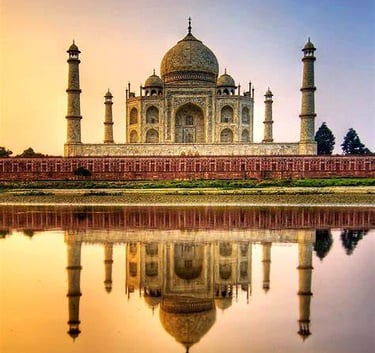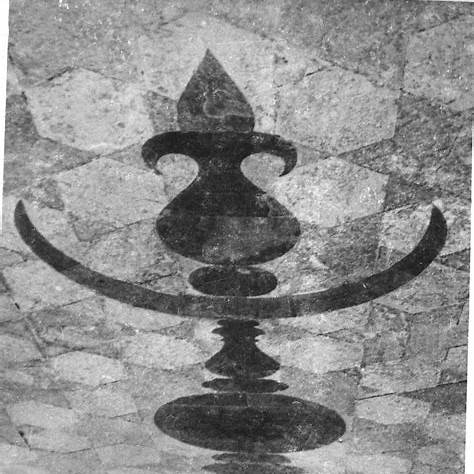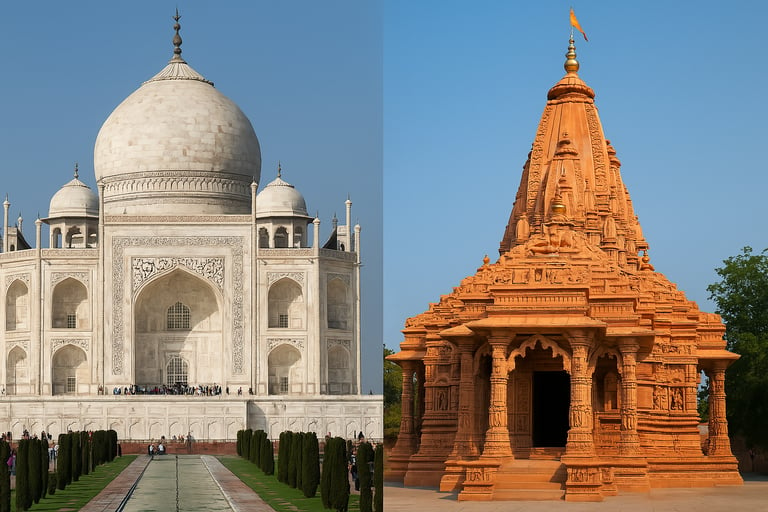The Hidden Truth of Taj Mahal: Was It Originally a Hindu Temple?
Was it truly built by Shah Jahan, or was it an ancient Hindu temple repurposed as a Mughal monument? While history books largely ignore these claims, many historians and researchers suggest that the Taj Mahal was originally a Hindu temple named "Tejo Mahalaya", dedicated to Lord Shiva.
HISTORY
3/29/20257 min read


The Hidden Truth of Taj Mahal: Was It Originally a Hindu Temple?
The Taj Mahal, celebrated worldwide as a symbol of love, is considered one of the greatest architectural wonders. However, beyond its mainstream narrative, there are alternative theories that question its origins. Was it truly built by Shah Jahan, or was it an ancient Hindu temple repurposed as a Mughal monument? While history books largely ignore these claims, many historians and researchers suggest that the Taj Mahal was originally a Hindu temple named "Tejo Mahalaya", dedicated to Lord Shiva.
This article dives deep into these claims, analyzing historical records, Mughal policies toward Hindu temples, and what the Archaeological Survey of India (ASI) and historians have said about the matter.
The Tejo Mahalaya Theory: What Historians Say
The theory that the Taj Mahal was once a Hindu temple-palace gained traction with historian P.N. Oak, who argued that the structure predated Shah Jahan's reign. In his book "Taj Mahal: The True Story", Oak presented evidence suggesting that the so-called "Taj Mahal" was actually a Hindu temple-palace named Tejo Mahalaya, which the Mughals forcibly took over.
His key arguments were:
✅ The name Taj Mahal has no Persian or Arabic meaning, whereas Tejo Mahalaya aligns with Hindu temple naming conventions.
✅ The structure contains typical Hindu architecture elements, such as lotus motifs, octagonal designs, and domes resembling Hindu temple styles.
✅ Certain underground rooms in the Taj Mahal have been sealed by the ASI, raising suspicions that they might contain remnants of Hindu idols.
✅ Shah Jahan's official court documents do not mention the construction of the Taj Mahal, which is strange for a monument of such grandeur.
Despite the Supreme Court of India dismissing Oak’s petition to officially recognize the Taj Mahal as a Hindu temple, his claims have never been completely debunked. Many believe that the historical evidence deserves a thorough, unbiased investigation.
Mughal Destruction of Hindu Temples: A Historical Reality
To understand whether the Taj Mahal was indeed a converted Hindu temple, it’s crucial to examine how Mughals treated Hindu religious sites. Historical records confirm that Mughal rulers, especially Aurangzeb, were responsible for large-scale destruction of Hindu temples.
🔹 The Kashi Vishwanath temple in Varanasi was destroyed and replaced with the Gyanvapi Mosque.
🔹 The Krishna Janmabhoomi temple in Mathura faced repeated destruction.
🔹 The Martand Sun Temple in Kashmir was reduced to ruins under Islamic rule.
Mughal rulers frequently took over grand Hindu temples and repurposed them into Islamic structures, either as mosques or tombs. If this was a common practice, why should the Taj Mahal be an exception?
Many architectural elements of the Taj Mahal closely resemble Hindu temple designs rather than traditional Mughal tombs, strengthening the argument that it may not have been built from scratch by Shah Jahan.
What the ASI Surveys Say
The Archaeological Survey of India (ASI) has conducted studies on the Taj Mahal but remains silent on the Tejo Mahalaya theory. Some significant findings, however, raise important questions:
📌 Sealed Chambers: The Taj Mahal has multiple underground chambers that remain sealed off to the public. Why are they inaccessible if there is nothing to hide?
📌 Unusual Construction Style: Some structural elements differ from other Mughal tombs, suggesting that the building might have been repurposed rather than built from scratch.
📌 Inscription Anomalies: Some researchers claim that Sanskrit inscriptions and Hindu symbols have been found on the premises, but the ASI has never openly investigated them.
If the ASI conducts an unbiased and thorough excavation of the sealed chambers, we may get conclusive proof about the Taj Mahal's true origins. But until then, the mystery remains.
Countering the Left-Lobby Narrative on the Taj Mahal’s Origins
The left-leaning intellectuals, historians, and media outlets often dismiss the theory that the Taj Mahal was originally a Hindu temple as a "Hindutva myth" or "revisionist history." However, their arguments are based on selective evidence, ignorance of historical Mughal policies, and dismissal of valid research.
This section will systematically debunk their claims and establish why a deeper investigation into the Taj Mahal’s origins is necessary.
CLAIM #1: The Taj Mahal was built entirely by Shah Jahan
Counter-Argument: There is no solid evidence in Mughal records confirming the Taj Mahal was built from scratch.
📌 No mention of construction in Shah Jahan’s court records
Mughal court historian Abdul Hamid Lahori documented many of Shah Jahan’s projects in his book Badshahnama. However, he does not describe the detailed construction of the Taj Mahal, only its completion.
Why would a grand project of this scale not have a single elaborate record of its construction?
📌 Mughal practice of repurposing Hindu structures
Babur, Humayun, Akbar, and Aurangzeb all converted Hindu temples into mosques and other Islamic monuments.
The Gyanvapi Mosque in Varanasi and the Shahi Eidgah Mosque in Mathura were once temples before being converted.
If the Mughals frequently took over Hindu sites, why should the Taj Mahal be an exception?
📌 No evidence of land acquisition by Shah Jahan
If Shah Jahan truly built the Taj Mahal, there should be records of him purchasing the land.
No such record exists. The theory that he “bought” the land from a Rajput ruler has no documentary proof.
📌 Sealed Chambers – What is the Mughal administration hiding?
The Taj Mahal has numerous sealed chambers that remain inaccessible to the public.
What is inside them? Why has the ASI never conducted a transparent excavation?
If the Taj Mahal was built from scratch, why are some areas restricted?
CLAIM #2: The Taj Mahal is built in Islamic architectural style
Counter-Argument: The design of the Taj Mahal has several elements of Hindu temple architecture.
📌 Hindu-style dome and chhatris
The octagonal shape of the Taj Mahal is typical of Hindu temple structures.
The lotus motifs and Kalash designs on the Taj Mahal resemble Hindu architecture, not Islamic tomb designs.
📌 Absence of Quranic Inscriptions in Certain Places
Most Mughal structures contain heavy Quranic inscriptions, yet many parts of the Taj Mahal lack Islamic calligraphy.
The presence of sacred Hindu symbols inside the Taj Mahal raises serious questions.
📌 Multiple Pillared Chambers – A Temple Feature
Hindu temples have multiple rooms (garbhagriha), while Islamic tombs have a single central chamber.
The Taj Mahal’s sealed basement chambers resemble temple structures, not an Islamic tomb.
📌 Vedic Design Elements
Hindu-style gardens and water distribution systems are found in the Taj Mahal complex, further suggesting that it could be a converted Hindu temple-palace.
CLAIM #3: The ASI has debunked the Tejo Mahalaya theory
Counter-Argument: The ASI has never officially investigated this claim
📌 No excavation has ever been conducted in the Taj Mahal’s sealed rooms
If the government and the ASI are so confident that the Taj Mahal was built by Shah Jahan, why not open the sealed chambers for a full-fledged excavation?
In 2022, a petition was filed in the Allahabad High Court demanding access to the Taj Mahal’s closed rooms, but it was rejected without investigation.
What exactly is the ASI trying to hide?
📌 Contradictory ASI Statements
While the ASI claims that Shah Jahan built the Taj Mahal, it fails to explain why there are traces of pre-Mughal architecture inside the structure.
The ASI has also acknowledged that the Yamuna riverfront had numerous Hindu temples before Mughal rule—but refuses to consider the possibility that one of them might have been the Taj Mahal.
📌 International Examples of Temple Conversions
Around the world, many grand religious structures have been repurposed.
Hagia Sophia in Turkey was once a Christian cathedral before being turned into a mosque.
In India, countless mosques stand on the ruins of destroyed Hindu temples.
If such temple conversions are a historical reality, why is the possibility of the Taj Mahal being one completely dismissed?
Nehruvian-Leftist Domination in Indian History Writing
After independence, instead of reclaiming India’s true history, the Nehruvian-leftist elite continued the British tradition of suppressing Hindu history.
📌 Nehru and his advisors like Romila Thapar, Irfan Habib, and R.S. Sharma promoted a pro-Mughal, anti-Hindu narrative.
📌 They controlled NCERT and university curriculums, ensuring that the destruction of Hindu temples was either ignored or justified as "political actions."
📌 They called historical truths ‘communal’ and dismissed any alternative views as “Hindutva propaganda.”
💡 Result? Even today, school textbooks praise Akbar, glorify Aurangzeb, and completely ignore Hindu temple destructions.
Political Compulsions and Vote-Bank Politics
Indian politics has been heavily driven by appeasement rather than historical truth.
📌 Many political parties, especially the Congress, Communists, and certain regional parties, have thrived on Muslim vote banks.
📌 Acknowledging Hindu temple destructions would mean admitting that Mughals were not the ‘secular’ rulers they are portrayed as.
📌 Any demand to reclaim Hindu heritage (like Kashi Vishwanath or Mathura) is labeled ‘communal’ and opposed for vote-bank reasons.
💡 Result? Politicians avoid speaking on these issues to maintain their “secular” image and keep their vote banks intact.
Academic and Media Whitewashing
The Indian media and academic institutions are largely controlled by left-liberals, who aggressively suppress Hindu historical claims.
📌 Mainstream historians dismiss temple destruction as ‘political acts’, not religious persecution.
📌 Any discussion on Mughal atrocities is ridiculed, while Hindu rulers are shown as “casteist oppressors.”
📌 Left-leaning newspapers (The Hindu, The Wire, Scroll, NDTV, etc.) actively censor Hindu historical narratives.
💡 Result? If a historian even tries to research temple destruction, they are blacklisted or labeled as “communal”.
What Can Be Done to Change This?
If Hindus want to reclaim their history, they must take active steps:
✅ Demand real history in school textbooks – The government should remove leftist distortions and present unbiased facts.
✅ Promote alternative research – Encourage scholars to investigate temple destructions, sealed chambers of the Taj Mahal, and publish findings.
✅ Boycott anti-Hindu media – Stop consuming content from platforms that glorify Mughals while demonizing Hindu kings.
✅ Use social media for awareness – Platforms like Instagram, YouTube, and Twitter can be used to educate people on real history.
✅ Ask for an ASI Investigation into the Taj Mahal’s sealed rooms – If there is nothing to hide, why not open the sealed chambers?
Conclusion: A Call for Further Investigation
While mainstream historians continue to dismiss the theory that the Taj Mahal was originally a Hindu temple, there are too many unanswered questions to ignore the possibility. If Kashi Vishwanath and Krishna Janmabhoomi were taken over by Islamic rulers, why not the Taj Mahal? If several temples were destroyed and converted into mosques, why should we assume that the Mughals built this structure from scratch?
It is time for a transparent and unbiased investigation to uncover the truth. The government and ASI must conduct proper research, allow access to the sealed chambers, and answer the historical doubts surrounding one of India's most famous monuments.
Whether the Taj Mahal is truly a Mughal masterpiece or a stolen Hindu temple repurposed as a tomb, history deserves to be told honestly.



